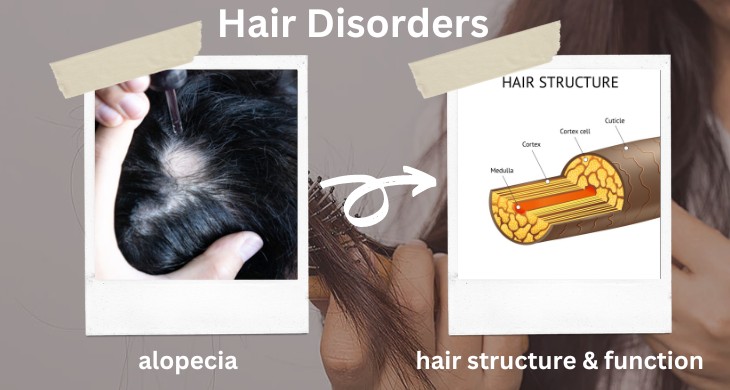Exploring the Categorization of Hair Based on Pathological Conditions

Introduction
Hair is not only a defining aspect’s of our appearance but also a reflection of our overall health. However , just like any other part of our body, hair can be subject to various disorders that affect its structure and function. These hair disorders encompass a range of conditions, from hair loss to abnormalities in hair shafts and scalp disorders. By categorizing hair based on these pathological conditions, researchers can deepen their understanding of the underlying causes and develop potential therapeutic interventions. In this article, we will explore the categorization of hair disorders & delve into some of the most common conditions that impact the health of our locks.
Categorizing Hair Disorders
Hair disorders canbe categorized into different types based on the specific pathological conditions they encompass. Here are some of the main categories of hair disorders:
- Alopecia – Understanding Hair Loss Conditions
- Androgenetic Alopecia (Male Pattern Baldness and Female Pattern Hair Loss)
- Alopecia Areata (Patchy Hair Loss)
- Telogen Effluvium (Temporary Hair Shedding)
- Traction Alopecia (Hair Loss due to Traction or Pulling)
- Hair Shaft Disorders – Abnormalities in Hair Structure
- Trichorrhexis Nodosa (Brittle Hair with Nodules)
- Trichorrhexis Invaginata (Bamboo Hair)
- Monilethrix (Beaded Hair)
- Pili Torti (Twisted Hair Shaft)
- Scalp Disorders – Conditions Affecting the Scalp and Hair Follicles
- Seborrheic Dermatitis (Dandruff)
- Psoriasis (Scaly Patches on the Scalp)
- Folliculitis (Inflammation of Hair Follicles)
- Tinea Capitis (Fungal Infection of the Scalp)
- Hair Texture Disorders – Abnormalities in Hair Texture
- Hypertrichosis (Excessive Hair Growth)
- Hypotrichosis (Sparse Hair Growth)
- Trichorrhexis Simplex (Fragile Hair)
- Ehlers-Danlos Syndrome (Thin, Elastic Hair)
- Inflammatory Hair Disorders – Inflammation Based Hair Conditions
- Lichen Planopilaris (Cicatricial Alopecia)
- Central Centrifugal Cicatricial Alopecia (CCCA)
- Discoid Lupus Erythematosus (DLE)
- Frontal Fibrosing Alopecia (FFA)
- Congenital Hair Disorders – Hair Conditions Present from Birth
- Netherton Syndrome (Sparse, Brittle Hair)
- Loose Anagen Syndrome (Loose Hair Shafts)
- Menkes Disease (Kinky Hair)
- Hypotrichosis with Juvenile Macular Dystrophy (Sparse Hair with Vision Loss)
FAQs (Frequently Asked Questions)
- Q: Are all types of hair loss considered alopecia?
- No, while all types of hair loss involve a disruption in hair growth, not all cases are classified as alopecia. Alopecia specifically refers to certain types of hair loss, such as androgenetic alopecia, alopecia areata, and others.
- Q: Can hair disorders be treated or managed?
- Yes, many hair disorders can be treated or managed with appropriate interventions. Treatment options may include medications, lifestyle modifications, hair care practices, or surgical procedures, depending on the specific condition.
- Q: Are hair disorders solely caused by genetics?
- While genetic factors can play a significant role in some hair disorders, other factors such as hormonal imbalances, autoimmune responses, infections, or external trauma can also contribute to these conditions.
- Q: Can scalp disorders lead to hair loss?
- Yes, certain scalp disorders, like seborrheic dermatitis or folliculitis, can cause inflammation or damage to hair follicles, leading to hair loss or thinning.
- Q: Are there preventive measures for hair disorders?
- While not all hair disorders can be prevented, maintaining a healthy lifestyle, practicing good hair hygiene, and avoiding excessive heat or chemical treatments can help reduce the risk of certain conditions.
- Q: Can hair disorders affect one’s emotional well-being?
- Yes, hair disorders can have a significant impact on an individual’s self-esteem and emotional well-being. The visible nature of hair disorders can cause distress and affect one’s body image and confidence.
Conclusion
Categorizing hair disorders based on their pathological conditions provides valuable insights into the underlying causes and manifestations of these conditions. By understanding the specific types of hair disorders and their impact on hair structure and function, researchers and medical professionals can develop targeted therapeutic interventions. Whether it is addressing hair loss, abnormalities in hair shafts, or scalp disorders, advancements in the field of hair disorder categorization pave the way for improved management and treatment options. Through ongoing research and advancements, we continue to unravel the complexities of hair disorders and work towards better outcomes for those affected.
